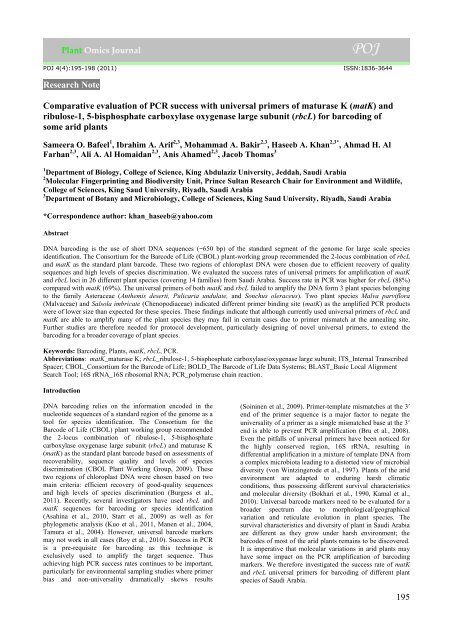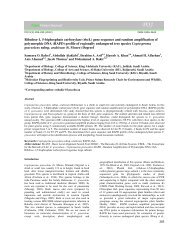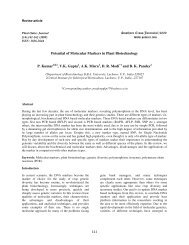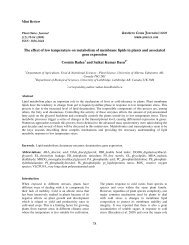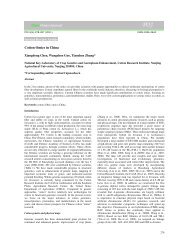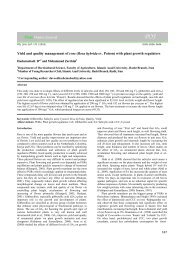Create successful ePaper yourself
Turn your PDF publications into a flip-book with our unique Google optimized e-Paper software.
POJ 4(4):195-198 (2011)ISSN:1836-3644Research <strong>Note</strong>Comparative evaluation of PCR success with universal primers of maturase K (matK) andribulose-1, 5-bisphosphate carboxylase oxygenase large subunit (rbcL) for barcoding ofsome arid plantsSameera O. Bafeel 1 , Ibrahim A. Arif 2,3 , Mohammad A. Bakir 2,3 , Haseeb A. Khan 2,3* , Ahmad H. AlFarhan 2,3 , Ali A. Al Homaidan 2,3 , Anis Ahamed 2,3 , Jacob Thomas 31 Department of Biology, College of Science, King Abdulaziz University, Jeddah, Saudi Arabia2 Molecular Fingerprinting and Biodiversity Unit, Prince Sultan Research Chair for Environment and Wildlife,College of Sciences, King Saud University, Riyadh, Saudi Arabia3 Department of Botany and Microbiology, College of Sciences, King Saud University, Riyadh, Saudi Arabia*Correspondence author: khan_haseeb@yahoo.comAbstractDNA barcoding is the use of short DNA sequences (~650 bp) of the standard segment of the genome for large scale speciesidentification. The Consortium for the Barcode of Life (CBOL) plant-working group recommended the 2-locus combination of rbcLand matK as the standard plant barcode. These two regions of chloroplast DNA were chosen due to efficient recovery of qualitysequences and high levels of species discrimination. We evaluated the success rates of universal primers for amplification of matKand rbcL loci in 26 different plant species (covering 14 families) from Saudi Arabia. Success rate in PCR was higher for rbcL (88%)compared with matK (69%). The universal primers of both matK and rbcL failed to amplify the DNA form 3 plant species belongingto the family Asteraceae (Anthemis deserti, Pulicaria undulate, and Sonchus oleraceus). Two plant species Malva parviflora(Malvaceae) and Salsola imbricate (Chenopodiaceae) indicated different primer binding site (matK) as the amplified PCR productswere of lower size than expected for these species. These findings indicate that although currently used universal primers of rbcL andmatK are able to amplify many of the plant species they may fail in certain cases due to primer mismatch at the annealing site.Further studies are therefore needed for protocol development, particularly designing of novel universal primers, to extend thebarcoding for a broader coverage of plant species.Keywords: Barcoding, <strong>Plant</strong>s, matK, rbcL, PCR.Abbreviations: matK_maturase K; rbcL_ribulose-1, 5-bisphosphate carboxylase/oxygenase large subunit; ITS_Internal TranscribedSpacer; CBOL_Consortium for the Barcode of Life; BOLD_The Barcode of Life Data Systems; BLAST_Basic Local AlignmentSearch Tool; 16S rRNA_16S ribosomal RNA; PCR_polymerase chain reaction.IntroductionDNA barcoding relies on the information encoded in thenucleotide sequences of a standard region of the genome as atool for species identification. The Consortium for theBarcode of Life (CBOL) plant working group recommendedthe 2-locus combination of ribulose-1, 5-bisphosphatecarboxylase oxygenase large subunit (rbcL) and maturase K(matK) as the standard plant barcode based on assessments ofrecoverability, sequence quality and levels of speciesdiscrimination (CBOL <strong>Plant</strong> Working Group, 2009). Thesetwo regions of chloroplast DNA were chosen based on twomain criteria: efficient recovery of good-quality sequencesand high levels of species discrimination (Burgess et al.,2011). Recently, several investigators have used rbcL andmatK sequences for barcoding or species identification(Asahina et al., 2010, Starr et al., 2009) as well as forphylogenetic analysis (Kuo et al., 2011, Manen et al., 2004,Tamura et al., 2004). However, universal barcode markersmay not work in all cases (Roy et al., 2010). Success in PCRis a pre-requisite for barcoding as this technique isexclusively used to amplify the target sequence. Thusachieving high PCR success rates continues to be important,particularly for environmental sampling studies where primerbias and non-universality dramatically skews results(Soininen et al., 2009). Primer-template mismatches at the 3end of the primer sequence is a major factor to negate theuniversality of a primer as a single mismatched base at the 3end is able to prevent PCR amplification (Bru et al., 2008).Even the pitfalls of universal primers have been noticed forthe highly conserved region, 16S rRNA, resulting indifferential amplification in a mixture of template DNA froma complex microbiota leading to a distorted view of microbialdiversity (von Wintzingerode et al., 1997). <strong>Plant</strong>s of the aridenvironment are adapted to enduring harsh climaticconditions, thus possessing different survival characteristicsand molecular diversity (Bokhari et al., 1990, Kamal et al.,2010). Universal barcode markers need to be evaluated for abroader spectrum due to morphological/geographicalvariation and reticulate evolution in plant species. Thesurvival characteristics and diversity of plant in Saudi Arabiaare different as they grow under harsh environment; thebarcodes of most of the arid plants remains to be discovered.It is imperative that molecular variations in arid plants mayhave some impact on the PCR amplification of barcodingmarkers. We therefore investigated the success rate of matKand rbcL universal primers for barcoding of different plantspecies of Saudi Arabia.195
Results and discussionWe observed a high success rate of rbcL universal primersthan matK primers for PCR amplification of 26 plant speciesrepresenting a wide coverage of 14 families. Out of 26specimens, 23 (88%) were successfully amplified using rbcL-A and rbcL-B primer-pairs; both these pairs were equallyeffective in amplification success however the former pairresulted more intense bands. In contrast, only 7 (27%) and 18(69%) samples could be amplified by matK-A and matK-Bprimer-pairs respectively (Fig. 1). These findings corroboratewith the previous report on evaluation of the seven maincandidate plastid regions (rbcL, matK, rpoC1, rpoB, trnHpsbA,atpF-atpH, and psbK-psbI) in three divergent groups ofland plants (angiosperm, gymnosperm, and liverwort)demonstrated that no single locus has high levels ofuniversality and resolvability (Hollingsworth et al., 2009).The successful isolation of quality DNA plays an importantrole in molecular characterization using PCR-based methods.Numerous problems have been reported about the isolation ofplant DNA. Isolated plant DNA may contain coloredsubstances, polysaccharides and phenolic compounds (Araset al., 1993; Temiesak et al., 1993; Vanijajiva et al., 2005).The presence of certain metabolites may interfere with theplant DNA isolation procedures and downstream reactionssuch as PCR amplification. The chemotypic heterogeneityamong species may not permit optimal DNA yields with asingle protocol, and thus, even closely related species mayrequire different DNA isolation protocols (Khanuja et al.,1999). PCR conditions constitute one of the crucial factorsfor obtaining amplified products, especially for plants (Joneset al., 1997). In terms of absolute discriminatory power,promising results occurred in liverworts using rbcL alone(90% species discrimination) (Hollingsworth et al., 2009).Two plant species Malva parviflora (Malvaceae) and Saldolaimbricate (Chenopodiaceae) resulted in smaller amplifiedPCR product than the expected size with primers matK-A,indicating a different primer binding site for these species(Fig. 1). Three plant species belonging to the familyAsteraceae (Anthemis deserti, Pulicaria undulate, andSonchus oleraceus) were not amplified using the universalmatK and rbcL primers. The family Asteraceae (Compositae)is the largest family of the flowering plants and it seems to beanomalous as combined analyses of 10 chloroplast DNA locishowed 12 major lineages of this family (Panero and Funk,2008). The central concept in species identification is tomatch the sequence of the evidence item to a referencesequence, either through DNA sequence similarity searches(Altschul et al., 1997) or by phylogenetic reconstruction(Baker, 1994). Except RFLP, all the molecular markersincluding the barcoding genes require PCR-based protocols(Kumar et al., 2009). The use of universal primers isimportant for retrospective species identification as theyallow amplification across a wide taxonomic range governedby the PCR success rates, particularly for new or rarelystudied plant species of arid region. PCR amplification ofmatK and rbcL gene segments is a prerequisite forsubsequent sequencing of plant barcodes towards speciesidentification. Primer bias and non-universality have beenreported for dramatically skewing results (Soininen et al.,2009). Several studies have investigated the effects ofprimer-template mismatches and it has been demonstratedthat PCR can be prevented by a single mismatched base (Bruet al., 2008). Variation in primer specificity also affectssequence recovery at low DNA concentrations (Dawnay etal., 2007). Although we observed appreciable success inamplification of rbcL and matK genes, failure in PCRTable 1. List of plant specimens used in this study.FamilySpeciesApocynaceaeRhazya strictaAsteraceaeAchillea fragrantissimaAnthemis desertiPulicaria undulateScorzonera intricateSonchus oleraceusBrassicaceaeHorwoodia dicksoniaeMoricandia sinaicaZilla spinosaCaryophyllaceae Spergularia bocconiiChenopodiaceae Bassia eriophoraChenopodium muraleSalsola imbricateConvolvulaceae Convolvulus oxyphyllusEuphorbiaceaeAndrachene telephoidesGeraniaceaeErodium glaucophyllumE. laciniatumMalvaceaeMalva parvifloraPapilionaceaeAstragalus sieberiMelilotus indicaPoaceaePanicum antidotalePennisetum setaceumResedaceaeCaylusea hexagynaSolanaceaeLycium shawiiWithania somniferaZygophyllaceaeZygophyllum propinquumamplification in for certain species may be attributed toprimer mismatch at the annealing sites. The possibility ofpoor quality of extracted DNA in failed PCR is remotebecause we confirmed the quality of DNA on gel as well asspectrophotometrically. Moreover, in many cases, the sameDNA specimen showed negative amplification for matK butpositive PCR for rbcL, negating the role of poor DNA qualityor quantity in the former case. It is more likely that highfrequency of failure in PCR amplification of matK geneoccurred due to variations in the respective binding sites ofthese particular plant species of arid origin. The generation ofmatK sequences for ferns is currently problematic, becausethis part of the chloroplast genome underwent a strongrestructuring during the evolution of the fern clade (Duffy etal., 2009). Recently, rbcL and trnL-F were used (instead ofmatK) for the two locus barcoding of European ferns (de-Groot et al., 2011). Roy et al. (2010) have reported a poorsuccess in PCR for the species of Berberis. The maximumsuccess in PCR was observed with rbcL and ITS (97%),followed by trnH-psbA (92%) and matK (76%). The firstpractical problem for barcoding of plants is the acquirementof sufficiently clean DNA for multi-locus sequencing asisolated plant DNA contains PCR inhibitors (Aras et al.,1993; Temiesak et al., 1993; Vanijajiva et al., 2005). Thesecond technical issues of primer universality and sequencequality and complexity remain arguable for barcoding of allthe land plants of different region (Fox et al., 1992; Schneiderand Schuettpelz, 2006). Traditionally, the identification andcharacterization of cultivars and species has been based onmorphological and physiological traits which are sometimesdifficult (Kadkhodaei et al., 2010). Molecular tools that havebeen developed for the characterization for biodiversity mayallow classification of synonyms and detection of the originof species and cultivars (Rahman et al., 2009). Ongoingresearch on the development of universal primers, PCRconditions, and high throughput sequencing techniqueswould certainly enhance the application of DNA barcoding of196
Table 2. Primers used for amplification of matK and rbcL gene segments.Primer set Primer name Binding Primer sequence (5´– 3´)matK-A matK-2.1F Forward CCTATCCATCTGGAAATCTTAGmatK-5R Reverse GTTCTAGCACAAGAAAGTCGmatK-B matK-390F Forward CGATCTATTCATTCAATATTTCmatK-1326R Reverse TCTAGCACACGAAAGTCGAAGTrbcL-A rbcLaF Forward ATGTCACCACAAACAGAGACTAAAGCrbcLaR Reverse GTAAAATCAAGTCCACCRCGrbcL-B rbcL-1F Forward ATGTCACCACAAACAGAAACrbcL-724R Reverse TCGCATGTACCTGCAGTAGCFig 1. Agarose get electrophoretogram showing bands of PCR amplified products of matK and rbcL universal primers. M, marker100 bp ladder; arrows indicate the 800 bp size of the marker; 1. Horwoodia dicksoniae, 2. Rhazya stricta, 3. Pulicaria undulate, 4.Anthemis deserti, 5. Andrachene telephoides, 6. Zilla spinosa, 7. Caylusea hexagyna, 8. Achillea fragrantissima, 9. Lycium shawii,10. Moricandia sinaica, 11. Bassia eriophora, 12. Zygophyllum propinquum, 13. Withania somnifera, 14. Sonchus oleraceus, 15.Chenopodium murale, 16. Malva parviflora, 17. Salsola imbricate, 18. Scorzonera intricate, 19. Pennisetum setaceum, 20. Panicumantidotale, 21. Erodium laciniatum, 22. Erodium glaucophyllum, 23. Convolvulus oxyphyllus, 24. Astragalus sieberi, 25. Spergulariabocconii, 26. Melilotus indica.plants and development of genetic databases for moreefficient utilization of this technique.Materials and methods<strong>Plant</strong> materialThis study comprised of specimens from 26 plant speciescovering 14 families (Table 1). The leaf samples wereindividually placed in plastic pouches and transported to labwhere all the samples were stored at -80 o C until processed forDNA extraction.DNA extractionThe leaf samples were immersed in liquid nitrogen andcrushed using sterile mortal and pestle to get a fine powder.DNeasy plant mini kit (Qiagen) and an automated DNAextraction instrument (QIAcube, Qiagen) were used for DNAisolation. Quality of the extracted DNA was determinedusing gel electrophoresis and Nanodrop 8000Spectrophotometer (Thermo Scientific, Wilmington, USA).Isolated plant genomic DNA was preserved at -20 o C.PCRA total volume of 30 L of PCR reaction mixture containedthe following: 15 L of FideliTaq PCR Master Mix (USBCorporation, Cleveland, OH), giving a final concentration of200 M each deoxynucleotide and 1.5 mM MgCl 2 , 1 Meach primer (Table 2, Eurofins MWG Operon, Germany}, 2L of genomic DNA and the rest was adjusted with steriledistilled water. PCR amplification was performed with aVeriti 96 well thermal cycler (Applied Biosystems) asfollows: 95°C for 1 min, followed by 35 cycles of 95°C for30 s, T°C for 30 s and 68°C for 1 min, followed by anelongation step at 68°C for 5 min. All the PCR conditionswere the same for all the primer-pairs except the annealingtemperature (T) for different primer pairs as follows: 50 o Cfor matK-A, 45 o C for matK-B, 51 o C for rbcL-A and 48 o C forrbcL-B (Table 2).Agarose gel electrophoresisA long (20 x 14 cm) 1% agarose gel using 1x TAE buffercontaining 0.5 μg/mL ethidium bromide was used forelectrophoresis of PCR-products. Gel images were obtainedusing Proxima C16 Phi+ (Isogen Life Science) UVtransilluminator and Opticom (version 3.2.5; OptiGo)imaging system. The amplified PCR products weredetermined on gel for the presence or absence of the band.The size of PCR products resulting from the primer pairs ofthe specific barcoding gene were determined by using anAmersham 100-bp ladder (GE Healthcare) and the TotalLabTL100 1D software (version 2008.01).ConclusionThe findings of this preliminary study indicate that currentlyused universal primers of rbcL and matK are able to amplifyseveral of the plant species of arid origin with theamplification success rates of 88% and 69% respectively. Allthe primer pairs produced sharp bands that are suitable for197
gene sequencing. Notwithstanding their failure in certaincases, the currently used primers for rbcL and matK areuseful for plant barcoding until the discovery of moreefficient and robust primers for a broader coverage of plantspecies. Thus, there is a need for protocol development toenhance the amplification strategies including thedevelopment of new primers or primer cocktails for enhancedsuccess in barcoding of plant species of different regions.AcknowledgmentsThe authors extend their appreciation to the Deanship ofScientific Research at King Saud University, Riyadh, SaudiArabia for funding the work through the research groupproject No. RGP-VPP-009.ReferencesAltschul S, Madden T, Scha¨ffer A, Zhang, J, Zhang, Z,Miller W, Lipman DJ (1997) Gapped BLAST and PSI-BLAST: a new generation of protein database searchprograms. Nucleic Acids Res 25: 3389–3402.Aras S, Duran A, Yenilmez G (1993) Isolation of DNA forRAPD analysis from dry leaf material of some Hesperis L.specimens. <strong>Plant</strong> Mol Biol Rep 21: 461a-461f.Asahina H, Shinozaki J, Masuda K, Morimitsu Y, Satake M(2010) Identification of medicinal Dendrobium species byphylogenetic analyses using matK and rbcL sequences. JNat Med 64: 133-138.Baker, CS, Palumbi SR (1994) Which whales are hunted—amolecular genetic approach to monitoring whaling. Science265: 1538–1539.Bokhari UG, Alyaeesh F, Al-Noori M (1990) Nutritionalcharacteristics of important desert grasses in Saudi Arabia.J Range Manag 43: 202-204.Burgess KS, Fazekas AJ, Kesanakurti PR, et al (2011)Discriminating plant species in a local temperate florausing the rbcL+ matK DNA barcode. Meth Ecol Evol doi:10.1111/j.2041-210X.2011.00092.x.Bru D, Laurent FM, Philippot L (2008) Quantification of thedetrimental effect of a single primer-template mismatch byreal-time PCR using the 16s rRNA gene as an example.Appl Environ Microbiol 74: 1660–1663.CBOL <strong>Plant</strong> Working Group (2009) A DNA barcode for landplants. Proc Natl Acad Sci USA 106: 12794-12797.Dawnay N, Ogden R, McEwing R, Carvalho GR, Thorpe, RS(2007) Validation of the barcoding gene COI for use inforensic genetic species identification. Forensic Sci Int 173:1–6.de-Groot GA , During HJ, Maas JW, Schneider H, Vogel JC,Erkens RHJ (2011) Use of rbcL and trnL-F as a two-locusDNA barcode for identification of NW European ferns: anecological perspective. PLoS ONE 6: e16371.doi:10.1371/journal.pone.0016371.Duffy AM, Kelchner SA, Wolf PG (2009) Conservation ofselection on matK following an ancient loss of its flankingintron. Gene 438: 17–25.Fox GE, Wisotzkey JD, Jurtshuk PJr (1992) How close isclose: 16s rRNA sequence identity may not be sufficient toguarantee species identity. Int J Syst Bacteriol 42: 166-170.DOI 10.1099/00207713-42-1-166.Hollingsworth ML, Clark AA, Forrest LL, et al (2009)Selecting barcoding loci for plants: evaluation of sevencandidate loci with species-level sampling in threedivergent groups of land plants. Mol Ecol Resour 9: 439–457.Jones CJ, Edwards KJ, Castaglione S, et al (1997)Reproducibility testing of RAPD, AFLP and SSR markersin plants by a network of European laboratories. Mol Breed3: 381-390.Kadkhodaei S, Elahy M, Nekouei MK, Imani A, ShahnazariM, Mardi M, Javanmard A, Ariff AB (2010) A panel ofcultivate specific marker based on polymorphisms atmicrosatellite markers for Iranian cultivated Almonds(Prunus dulcis). Aust J Crop Sci 4: 730-736.Kamal AHM, Kim KH, Shin KH, Choi JS, Baik BK,Tsujimoto H, Heo HY, Park CS, Woo SH (2010) Abioticstress responsive proteins of wheat grain determined usingproteomics technique. Aust J Crop Sci 4:196-208.Khanuja SPS, Shasany AK, Darokar MP, Kumar S (1999)Rapid isolation of DNA from dry and fresh samples ofplants producing large amounts of secondary metabolitesand essential oils. <strong>Plant</strong> Mol Biol Rep 17: 1–7.Kumar P, Gupta VK, Misra AK, Modi DR, Pandey BK(2009) Potential of molecular markers in plantbiotechnology. <strong>Plant</strong> <strong>Omics</strong> J 2: 141-162.Kuo LY, Li FW, Chiou WL, Wang CN (2011) First insightsinto fern matK phylogeny. Mol Phylogenet Evol 59: 556-566.Manen JF, Habashi C, Jeanmonod D, Park JM, SchneeweissGM (2004) Phylogeny and intraspecific variability ofholoparasitic Orobanche (Orobanchaceae) inferred fromplastid rbcL sequences. Mol Phylogenet Evol 33: 482-500.Panero JL, Funk VA (2008) The value of samplinganomalous taxa in phylogenetic studies: major clades of theAsteraceae revealed. Mol Phylogenet Evol 47: 757-782.Rahman MS, Molla MR, Alam MS, Rahman L (2009) DNAfingerprinting of rice (Oryza sativa L.) cultivars usingmicrosatellite markers. Aust J Crop Sci 3: 122-128.Roy S, Tyagi A, Shukla V, et al (2010) Universal plant DNAbarcode loci may not work in complex groups: a case studywith Indian Berberis species. PLoS One 5: e13674.Schneider H, Schuettpelz E (2006) Identifying ferngametophytes using DNA sequences. Mol Ecol <strong>Note</strong>s 6:989–991.Soininen EM, Valentini A, Coissac E, et al (2009) Analyzingdiet of small herbivores: the efficiency of DNA barcodingcoupled with high-throughput pyrosequencing fordeciphering the composition of complex plant mixtures.Front Zool 6: 16.Starr JR, Naczi RF, Chouinard BN (2009) <strong>Plant</strong> DNAbarcodes and species resolution in sedges (Carex,Cyperaceae). Mol Ecol Resour 9 Suppl s1: 151-163.Tamura MN, Fuse S, Azuma H, Hasebe M. Biosystematicstudies on the family Tofieldiaceae I (2004) Phylogeny andcircumscription of the family inferred from DNAsequences of matK and rbcL. <strong>Plant</strong> Biol 6: 562-567.Temiesak P, Ponpim Y, Harada T (1993) RAPD analysis forvarietal identification in Brassica. Kasetsart J Nat Sci 27:37-42.Vanijajiva O, Sirirugsa P, Suvachittanont W (2005)Confirmation of relationships among Boesenbergia(Zingiberaceae) and related genera by RAPD. BiochemSyst Ecol 33: 159-170.von-Wintzingerode F, Gobel UB, Stackebrandt E (1997)Determination of microbial diversity in environmentalsamples: pitfalls of PCR-based rRNA analysis. FEMSMicrobiol Rev 21: 213–229.198


